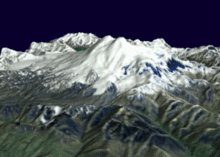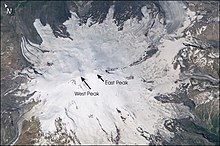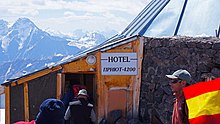Mount Elbrus
Mount Elbrus (Russian: Эльбрус; Karachay-Balkarian: Минги тау) is the highest peak in Russia and Europe, with an altitude of 5642 m above sea level. It is located in the western part of the Caucasian ridge — which, together with the Ural Mountains, marks the traditionally accepted border between Europe and Asia — in Kabardia-Balkaria (Russia), near the Georgian border.
Mount Elbrús has two summits, both dormant volcanic domes. The highest summit is located to the west and rises to 5,642 meters; the eastern summit measures 5621 meters. The eastern summit was first ascented on July 10, 1829 (Julian calendar) by Jillar Jachirov, and the western summit in 1874 by a British expedition led by F. Crauford Grove.
Among the discussions that exist around the border between Europe and Asia, the most relevant modern authorities define the continental limit as the Caucasus basin, which places Elbrus entirely in Europe due to its position on the northern side, in Russia.
Location
Elbrus is located 20 km north of the main divide of the Greater Caucasus in Russia, and 65 km southwest of the Russian city of Kislovodsk. Its permanent ice cap feeds twenty-two glaciers, from which the Baksan, Kuban and Malka rivers are born, among others.
Geology
The Caucasus is formed by the northward collision of the Arabian plate with the Eurasian plate causing many earthquakes in the region. The fault zone is complex and the mostly lateral displacement in Anatolia and Iran prevents the creation of a subduction phenomenon and explains the rarity of volcanoes in the range. Therefore, the Elbrús is one of the rare exceptions, consisting of metamorphic rocks (schists, gneisses) and magmatic rocks (granite, rhyolite, tuff).
Elbrús would have begun to form ten million years ago. Ejections from the volcano covered an area of 260 km². Rhyolite and rhyodacite fragments, and tuff and ignimbrite formations, were found and helped lead uranium-lead out of the main caldera formation 700,000 years ago, probably corresponding to the end of a major eruptive cycle. Geochronological dating has revealed synchronous subsequent eruptive cycles in different magma foci of the Greater Caucasus, demonstrating the common geological origin of this volcanic activity. Modest fumaroles escaping from the volcano's eastern flank can still form today, in the 24 km-long ancient lava flow, oriented from the crater to the north-northeast.
History
In ancient times the mountain was known as Strobilus, the Latin name for the strobile or pine cone, a direct borrowing from the ancient Greek strobilos, meaning "an object twisted" (a long-established botanical term that describes the shape of the volcano's top). According to mythology, Zeus had chained Prometheus there, the Titan who had stolen fire from the gods and given it to ancient man; probably a reference to the volcano's historical activity.
The first to reach the lower peak of the two that Elbrus has was Killar Kashirov, a Karachai guide from the scientific expedition of the Imperial Russian Army under the command of General Emmanuel, who achieved it on July 10, 1829 (Julian calendar). The second to ascend this summit were the Englishmen Douglas Freshfield, Adolphus Moore and C. C. Tucker, in 1868. The upper summit (about 40 m higher) was ascended for the first time by a British expedition led by Florence Crauford Grove and including Frederick Gardner, Horace Walker and the Swiss mountaineer Peter Knubel, in 1874.
During the early years of the Soviet Union, mountaineering became a popular mass sport, and there was considerable human trafficking up the mountain. In the winter of 1936, a very large group of inexperienced Komsomol members attempted to climb the mountain, only to suffer many deaths when they slipped on the ice and fell.
The German Wehrmacht briefly occupied the surrounding area during World War II with 10,000 soldiers from a division of Gebirgsjäger (mountain regiments), from August 1942 to January 1943. A history possibly apocryphal it tells that a Soviet pilot received a medal for bombing the main mountain hut, Priyut 11 (Russian: Приют одиннадцати|Приют одиннадцати, "Shelter of the 11"), while it was occupied. He was later nominated for a medal not for giving to the cabin but instead for the German fuel supply, leaving the cabin standing for future generations. When news reached Adolf Hitler that the general commanding the German division had sent a detachment of mountaineers to climb the top of Elbrus and plant the swastika flag on it, he is said to have been furious, dismissing the achievement as " trick" and threatening the general with a court martial.
During the existence of the Soviet Union, climbing Elbrus was encouraged, and in 1956 a mass ascent of four hundred mountaineers marked the four hundredth anniversary of the annexation of Kabardia-Balkaria, the autonomous republic in which Elbrus is located. Elbrús is represented on the flag of said republic.
From 1959 to 1976, a cable car system was built that in several stages takes visitors up to an altitude of 3,800m. There are a wide variety of routes to ascend the mountain, but the normal route, which is free of glacial crevasses, continues more or less straight up the slope where the final station of the cable car is located. During the summer, it can happen that one hundred people try to reach the summit in one day using this route. Winter ascents are rare, and are usually undertaken only by very experienced mountaineers. Elbrús is infamous for its brutal winter weather, and attempts to the summit are few and far between. The climb is not technically difficult, but it is physically demanding due to the altitude and frequent strong winds. The average number of deaths per year ranges from 15 to 30, due primarily to the many disorganized and poorly equipped attempts to reach the top of the mountain.
Mount Elbrus should not be confused with the Alborz (also called Elburz) Mountains in Iran, which also derive their name from the legendary Harā Bərəzaitī mountain in Persian mythology.
Traditionally the mythical Mont Blanc was thought to be the highest in Europe; however, Elbrús surpasses it considerably. Even today it is still a matter of dispute due to its position on the edge of Europe, in the Caucasus.
In 1997 a Land Rover Defender was driven to the summit, entering the Guinness Book of Records.
Climate
Elbrús is located in the northern hemisphere: the summer season, the least rigorous, runs from June to mid-September, with an average of 50% sunny days leading up to the ascent of the summit. However, the winds, dominated by air masses from the west, can become violent and temperatures drop very quickly. Above 4000m elevation, even in summer, arctic blizzard conditions can set in with almost no visibility. It is not uncommon for the wind to exceed 100 km/h. In winter, the temperature can drop below -50 °C at the top, but in the valleys, the warmer and drier air currents can cause heavy snowfall. At low altitudes, rainfall averages 500mm and can reach 1,000mm in some years, while above 2,000 meters it can exceed 1,500mm.
Flora and fauna
Flora
On the northern slope, between 1900 and 2300 m, the pine forest (Pinus kochiana and Pinus sylvestris) grows predominantly along with birch (Betula sp.) and mountain ash. Sea buckthorn (Hippophae rhamnoides), a shrub with silvery foliage, is present in the Baskan River valley. In subalpine meadows, grasses and flowers can reach 70 to 80 cm in height. One of the region's most beautiful flowering shrubs, the Caucasian rhododendron (Rhododendron caucasicum), grows there. Known locally as the 'alpine rose', its pale pink and cream flowers bloom in early spring. Its roots sink deep into the sloping ground, allowing it to withstand wind and snow.
Between 2,300 and 3,000 m above sea level, the subalpine soil gives way to alpine soil and its flower-rich alpine grass. Further on, on the edge of the glaciers and snowfields, multicolored lichens bloom, covering the snowless rocks. Between 3,000 and 3,500 m, at altitudes where plants are still able to grow, the cottony chickweed (Cerastium tomentosum), and saxifrage (Saxifraga Vinnica) can also be found in places among the lichens.
On the southern slope, up to 1600 m above sea level, beech, hornbeam, maple and ash trees grow. Between 1,600 and 2,100 m above sea level, the pine forest appears. Beyond this, alpine meadows offer flower species that are often absent on the northern slope.
Mountain forests are rich in mushrooms and berries: strawberries (Fragaria vesca), blueberry (Vaccinium myrtillus), black currant (Ribes nigrum) and raspberries (Rubus idaeus).
Wildlife
The Caucasus has a rich fauna. The forests are home to brown bears (Ursus arctos), various deer, marten, bobcat, polecat, mole, squirrel, and mouse.
The Caucasian chamois (Rupicapra Rupicapra caucasica) and the wild mountain goat (Capra aegagrus aegagrus) live in the pastures, on the border between forests and alpine meadows, where they feed on grasses and trees young shoots. The West Caucasian tur (Capra caucasica) lives in the hills during the day, in groups of eight to ten individuals, and grazes in alpine meadows in the afternoon. During the winter months, they form larger flocks and move to the valleys. In winter, when food is more difficult to find, the tur -like many animals- is attacked by wolves (Canis lupus).
Foxes also hunt on the slopes of Elbrús, including small rodents such as wood mice (Apodemus sylvaticus) and field mice (Microtus sp.). The lynx (Lynx lynx) preys on hares (Lepus europaeus) and roe deer (Capreolus capreolus). Measuring just 20cm from nose to tail, the European weasel (Mustela nivalis) is also a fierce predator, hunting large numbers of rodents. Wild boars (Sus scrofa) are common and form groups of eight to fifteen individuals.
Many birds inhabit the forests around Elbrús. Among them are six threatened species: the Caucasian grouse (Lyrurus mlokosiewiczi), the saker falcon (Falco cherrug), the golden eagle (Aquila chrysaetos), the peregrine falcon (Falco peregrinus), the imperial eagle (Aquila heliaca) and the bearded vulture (Gypaetus barbatus).
The Kaznakov's viper (Vipera kaznakovi), another threatened animal, is endemic to the region. Other relatively common amphibians can be seen: the common newt (Triturus vulgaris), the brown pelobate (Pelobates fuscus), the common toad (Bufo bufo) and green toad (Bufo viridis), green tree frog (Hyla arborea), black frog (Rana ridibunda) and brown frog (Rana macrocnemis).
Mountaineering in Elbrús
Mountaineering and climbing have been common sports for lovers of high mountains since their first ascent in the XIX century. Elbrús is one of the Seven World Summits and the roof of Europe, hence its importance for mountaineers.
The normal route is the easiest, safest, and fastest thanks to the cable car and chairlift system that runs from 9 a.m. to 5 p.m. m. until 3 p.m. m. Start the summit at 2 am. m. around the Diesel Hut or Leaprus hut should allow just enough time to get back to the chairlift if movement is efficient. A Longer Ascent The Kiukurtliu route starts from below the Mir cable car station and heads west over the slopes of the glaciers towards the Khotiutau pass.
The ascent of Elbrus from the south takes around 6-9 hours, with a total height difference of 1,700-2,000 m between the barrel huts and the western summit of Elbrus. The slopes surrounding the classical route to Elbrus from the south contain large cracks and are more difficult.
The descent of Elbrus takes about 3-6 hours. When returning from the Elbrus summit, the most common and often fatal mistake climbers make is descending too early, especially in poor visibility conditions in stormy weather.
The climbing route to the north requires more commitment and is more remote than the route to the south. Also contributing to this is the fact that at lower mountain altitudes this route may offer less infrastructure along the way. However, this also means less human intrusion into the landscape. With mechanical support reduced to a minimum, the trip to Elbrús from the north is mainly camping, with the longest and most difficult summit route, which requires good teamwork and/or winter camping, since if the weather is favourable, it is a provisional camp at 4800 m or gaining 2000 vertical m. The ascent of the Elbrús by the northern route offers an experience rich in ice and snow in unpredictable weather conditions.
In popular culture
Mount Elbrus is used as the backdrop for an episode of Koubatsou and the Century Games, Volume 2 of Mistscreens (Robert Belfiore's teen fantasy series). Astride her Macha gargoyle, the young warrior Opheline tries to escape from Guttur, a ferocious gargoyle responsible for eliminating them.
Elbrús has been represented by many artists.
Contenido relacionado
Sergipe
Cherkasy Oblast
Iruelos










